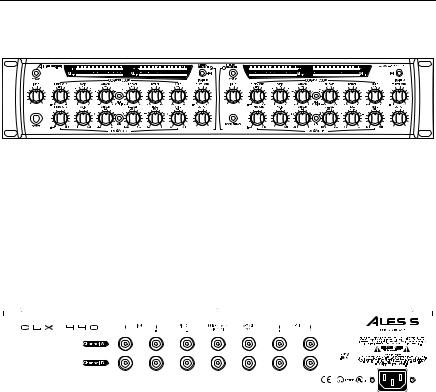Alesis CLX440 User Manual

Compressor / Limiter / Expander
Reference
Manual
2001
CLX-440 Reference Manual |
1 |

CLX-440 Manual
2 |
CLX-440 Reference Manual |

CLX-440 Manual |
|
Contents |
|
Contents........................................................................................................................ |
3 |
Welcome!..................................................................................................... |
6 |
How to Use This Manual ......................................................................... |
7 |
Important Safety Instructions.................................................................. |
8 |
CE Declaration of Conformity............................................................... |
10 |
Instructions to the User (FCC Notice).................................................. |
14 |
Quick Start Guide ..................................................................................................... |
15 |
If you can't wait to get started:.............................................................. |
15 |
Step 1: Hook it up to a mixer ........................................................ |
15 |
Step 2: Try some compression ...................................................... |
16 |
Step 3: Try some gating.................................................................. |
17 |
Connections ............................................................................................................... |
19 |
Unpacking and Inspection..................................................................... |
19 |
Installing in a Rack .................................................................................. |
19 |
Power ......................................................................................................... |
20 |
Connecting inputs and outputs ............................................................ |
22 |
Connecting to the Channel Inserts of a mixing console: ......... |
22 |
Connecting to the Main Inserts of a mixing console: ............... |
23 |
Connecting to the inserts on an instrument amplifier: ............ |
24 |
Connecting to equipment with XLR inputs and outputs:....... |
24 |
About Audio Cables................................................................................ |
25 |
Dual Channel Operation ........................................................................ |
26 |
Basics of Compression ............................................................................................ |
27 |
What is compression? ............................................................................. |
27 |
Description of Controls .......................................................................... |
28 |
Threshold ....................................................................................... |
28 |
Ratio ................................................................................................ |
29 |
Attack.............................................................................................. |
29 |
Release ............................................................................................ |
29 |
Detect .............................................................................................. |
29 |
Knee ................................................................................................ |
30 |
Compression Artifiacts........................................................................... |
31 |
Pumping and Breathing .............................................................. |
31 |
Clicking or "Zipper Noise" ......................................................... |
31 |
Reduced Gain Structure .............................................................. |
31 |
CLX-440 Reference Manual |
3 |

CLX-440 Manual |
|
Limiting ..................................................................................................... |
32 |
Limiter Threshold......................................................................... |
32 |
Stereo Detection ....................................................................................... |
33 |
Look Ahead Compression ..................................................................... |
33 |
Sidechain ................................................................................................... |
34 |
Basics of Expansion................................................................................................. |
35 |
What is expansion?.................................................................................. |
35 |
Description of Controls .......................................................................... |
36 |
Threshold ....................................................................................... |
36 |
Ratio ................................................................................................ |
36 |
Knee ................................................................................................ |
37 |
Attack.............................................................................................. |
37 |
Hold ................................................................................................ |
37 |
Release ............................................................................................ |
38 |
Keyed Expansion ..................................................................................... |
39 |
Applications............................................................................................................... |
41 |
Compressor Applications ...................................................................... |
41 |
Vocal Limiting............................................................................... |
41 |
Vocal Compression ...................................................................... |
42 |
Drums ............................................................................................. |
42 |
Bass.................................................................................................. |
43 |
Electric Guitar ............................................................................... |
43 |
Compressor Applications using the Sidechain.................................. |
44 |
De-essing........................................................................................ |
44 |
Ducking .......................................................................................... |
45 |
Expander Applications........................................................................... |
46 |
Gating a Noisy Guitar Amp ....................................................... |
46 |
Expanding Live Vocal Tracks .................................................... |
46 |
Expander Applications using the Key................................................. |
47 |
Gated Reverb................................................................................. |
47 |
Key Filtering for a Tom Mic gate............................................... |
48 |
Staccato Gating a Synth Pad....................................................... |
49 |
Troubleshooting ....................................................................................................... |
51 |
Troubleshooting Index ........................................................................... |
51 |
Avoiding ground loop noise ...................................................... |
52 |
Line Conditioners and Protectors ............................................. |
53 |
Care and Maintenance............................................................................ |
54 |
Cleaning ......................................................................................... |
54 |
Refer All Servicing to Alesis....................................................... |
54 |
Obtaining Repair Service ............................................................ |
55 |
Specifications............................................................................................ |
57 |
4 |
CLX-440 Reference Manual |

|
CLX-440 Manual |
Audio Input ................................................................................. |
57 |
Sidechain/ Key Inputs............................................................... |
57 |
Direct Output............................................................................... |
57 |
Audio Output .............................................................................. |
57 |
Audio Performance .................................................................... |
57 |
Mechanical ................................................................................... |
58 |
Alesis Limited Warranty ......................................................................................... |
59 |
CLX-440 Reference Manual |
5 |

CLX-440 Manual
Welcome!
Thank you for making the Alesis CLX-440™ a part of your studio. Since 1984, we've been designing and building creative tools for the audio community. We believe in our products, because we've heard the results that creative people like you have achieved with them. One of Alesis' goals is to make highquality studio equipment available to everyone, and this Reference Manual is an important part of that. After all, there's no point in making equipment with all kinds of capabilities if no one explains how to use them. So, we try to write our manuals as carefully as we build our products.
The goal of this manual is to get you the information you need as quickly as possible, with a minimum of hassle. We hope we've achieved that. If not, please drop us an email and give us your suggestions on how we could improve future editions of this manual.
We hope your investment will bring you many years of creative enjoyment and help you achieve your goals.
Sincerely,
The people of Alesis Studio Electronics
6 |
CLX-440 Reference Manual |

CLX-440 Manual
How to Use This Manual
This manual is divided into the following sections describing the various functions and applications for the CLX-440. While it's a good idea to read through the entire manual once carefully, those having general knowledge about studio equipment should use the table of contents to look up specific functions.
Chapter 1: Quick Start. If you're already familiar with recording, this will get you started using the CLX-440 right away. It's a short guide to the essential elements of connections and operation.
Chapter 2: Connections. This section gives detailed instructions for connecting the CLX-440 to a variety of typical audio systems.
Chapter 3: Basics of Compression. This section explains what a compressor does and explains the function of each of the controls.
Chapter 4: Basics of Expansion. This chapter explains the other major feature of the CLX-440, expansion, and each of the front panel controls dedicated to this function.
Chapter 5: Applications. Skip to this section for tips on using the CLX-440 with a variety of audio sources.
Chapter 6: Troubleshooting. Refer to this chapter if you experience any problems while using the CLX-440.
Helpful tips and advice are highlighted in a shaded box like this.
The names of specific controls or connectors on the CLX-440 are printed in a special font, i.e., the BYPASS button.
When something important appears in the manual, an icon
(like the one on the left) will appear in the left margin. This symbol indicates that this information is vital when operating the CLX-440.
CLX-440 Reference Manual |
7 |

CLX-440 Manual
Important Safety Instructions
Safety symbols used in this product:
 This symbol alerts the user that there are important operating and maintenance instructions in the literature accompanying this unit.
This symbol alerts the user that there are important operating and maintenance instructions in the literature accompanying this unit.
 This symbol warns the user of uninsulated voltage within the unit that can cause dangerous electric shocks.
This symbol warns the user of uninsulated voltage within the unit that can cause dangerous electric shocks.
 This symbol warns the user that output connectors contain voltages that can cause dangerous electrical shock.
This symbol warns the user that output connectors contain voltages that can cause dangerous electrical shock.
Please follow these precautions when using this product:
 1. Read these instructions.
1. Read these instructions.
2.Keep these instructions.
3.Heed all warnings.
4.Follow all instructions.
5.Do not use this apparatus near water.
6.Clean only with a damp cloth. Do not spray any liquid cleaner onto the faceplate, as this may damage the front panel controls or cause a dangerous condition.
7.Install in accordance with the manufacturer's instructions.
8.Do not install near any heat sources such as radiators, heat registers, stoves, or other apparatus (including amplifiers) that produce heat.
 9. Do not defeat the safety purpose of the polarized or groundingtype plug. A polarized plug has two blades with one wider than the other. A grounding-type plug has two blades and a third grounding prong. The wide blade or the third prong are provided for your safety. When the provided plug does not fit
9. Do not defeat the safety purpose of the polarized or groundingtype plug. A polarized plug has two blades with one wider than the other. A grounding-type plug has two blades and a third grounding prong. The wide blade or the third prong are provided for your safety. When the provided plug does not fit
8 |
CLX-440 Reference Manual |

CLX-440 Manual
into your outlet, consult an electrician for replacement of the obsolete outlet.
10.Protect the power cord from being walked on or pinched, particularly at plugs, convenience receptacles, and the point where they exit from the apparatus.
11.Use only attachments or accessories specified by the manufacturer.
12.Use only with a cart, stand, bracket, or table designed for use with professional audio or music equipment. In any installation, make sure that injury or damage will not result from cables pulling on the apparatus and its mounting. If a cart is used, use caution when moving the cart/apparatus combination to avoid injury from tip-over.
13.Unplug this apparatus during lightning storms or when unused for long periods of time.
 14. Refer all servicing to qualified service personnel. Servicing is required when the apparatus has been damaged in any way, such as when the power-supply cord or plug is damaged, liquid has been spilled or objects have fallen into the apparatus, the apparatus has been exposed to rain or moisture, does not operate normally, or has been dropped.
14. Refer all servicing to qualified service personnel. Servicing is required when the apparatus has been damaged in any way, such as when the power-supply cord or plug is damaged, liquid has been spilled or objects have fallen into the apparatus, the apparatus has been exposed to rain or moisture, does not operate normally, or has been dropped.
15.This unit produces heat when operated normally. Operate in a well-ventilated area with at least six inches of clearance from peripheral equipment.
16.This product, in combination with an amplifier and headphones or speakers, may be capable of producing sound levels that could cause permanent hearing loss. Do not operate for a long period of time at a high volume level or at a level that is uncomfortable. If you experience any hearing loss or ringing in the ears, you should consult an audiologist.
17.Do not expose the apparatus to dripping or splashing. Do not place objects filled with liquids (flower vases, softdrink cans, coffee cups) on the apparatus.
18.WARNING: To reduce the risk of fire or electric shock, do not expose this apparatus to rain or moisture.
CLX-440 Reference Manual |
9 |

CLX-440 Manual
Instructions de Sécurité Importantes (French)
Symboles utilisés dans ce produit
 Ce symbole alèrte l’utilisateur qu’il existe des instructions de fonctionnement et de maintenance dans la documentation jointe avec ce produit.
Ce symbole alèrte l’utilisateur qu’il existe des instructions de fonctionnement et de maintenance dans la documentation jointe avec ce produit.
 Ce symbole avertit l’utilisateur de la présence d’une tension non isolée à l’intérieur de l’appareil pouvant engendrer des chocs électriques.
Ce symbole avertit l’utilisateur de la présence d’une tension non isolée à l’intérieur de l’appareil pouvant engendrer des chocs électriques.
 Ce symbole prévient l'utilisateur de la présence de tensions sur les raccordements de sorties, représentant un risque d'électrocution.
Ce symbole prévient l'utilisateur de la présence de tensions sur les raccordements de sorties, représentant un risque d'électrocution.
Veuillez suivre ces précautions lors de l’utilisation de l’appareil:
 1. Lisez ces instructions.
1. Lisez ces instructions.
2.Gardez ces instructions.
3.Tenez compte de tous les avertissements.
4.Suivez toutes les instructions.
5.N’utilisez pas cet allareil à proximité de l’eau.
6.Ne nettoyez qu’avec un chiffon humide. Il est potentiellement dangereux d'utiliser des pulvérisateurs ou nettoyants liquides sur cet appareil.
7.Installez selon les recommandations du constructeur.
8.Ne pas installer à proximilé de sources de chaleur comme radiateurs, cuisinière ou autre appareils (don’t les amplificateurs) produisant de la chaleur.
 9. Ne pas enlever la prise de terre du cordon secteur. Une prise murale avec terre deux broches et une troisièrme reliée à la terre. Cette dernière est présente pour votre sécurité. Si le cordon secteur ne rentre pas dans la prise de courant, demandez à un électricien qualifié de remplacer la prise.
9. Ne pas enlever la prise de terre du cordon secteur. Une prise murale avec terre deux broches et une troisièrme reliée à la terre. Cette dernière est présente pour votre sécurité. Si le cordon secteur ne rentre pas dans la prise de courant, demandez à un électricien qualifié de remplacer la prise.
10 |
CLX-440 Reference Manual |

CLX-440 Manual
10.Evitez de marcher sur le cordon secteur ou de le pincer, en particulier au niveau de la prise, et aux endroits où il sor de l’appareil.
11.N’utilisez que des accessoires spécifiés par le constructeur.
12.N’utilisez qu’avec un stand, ou table conçus pour l’utilisation d’audio professionnel ou instruments de musique. Dans toute installation, veillez de ne rien endommager à cause de câbles qui tirent sur des appareils et leur support.
13.Débranchez l’appareil lors d’un orage ou lorsqu’il n’est pas utilisé pendant longtemps.
 14. Faites réparer par un personnel qualifié. Une réparation est nécessaire lorsque l’appareil a été endommagé de quelque sorte que ce soit, par exemple losrque le cordon secteur ou la prise sont endommagés, si du liquide a coulé ou des objets se sont introduits dans l’appareil, si celui-ci a été exposé à la pluie ou à l’humidité, ne fonctionne pas normalement ou est tombé.
14. Faites réparer par un personnel qualifié. Une réparation est nécessaire lorsque l’appareil a été endommagé de quelque sorte que ce soit, par exemple losrque le cordon secteur ou la prise sont endommagés, si du liquide a coulé ou des objets se sont introduits dans l’appareil, si celui-ci a été exposé à la pluie ou à l’humidité, ne fonctionne pas normalement ou est tombé.
15.Puisque son fonctionement normale génère de la chaleur, placez cet appareil au moins 15cm. des équipments péripheriques et assurez que l’emplacement permet la circulation de l’air.
16.Ce produit, utilisé avec un amplificateur et un casque ou des enceintes, est capable de produite des niveaux sonores pouvant engendrer une perte permanente de l’ouïe. Ne l’utilisez pas pendant longtemps à un niveau sonore élevé ou à un niveau non confortable. Si vous remarquez une perte de l’ouïe ou un bourdonnement dans les oreilles, consultez un spécialiste.
Beim Benutzen dieses Produktes beachten Sie bitte die folgenden Sicherheitshinweise: (German)
 1. Lesen Sie die Hinweise.
1. Lesen Sie die Hinweise.
2.Halten Sie sich an die Anleitung.
3.Beachten Sie alle Warnungen.
4.Beachten Sie alle Hinweise.
5.Bringen Sie das Gerät nie mit Wasser in Berührung.
CLX-440 Reference Manual |
11 |

CLX-440 Manual
6.Verwenden Sie zur Reinigung nur ein weiches Tuch. Verwenden Sie keine flüssigen Reinigungsmittel. Dies kann gefährliche Folgen haben.
7.Halten Sie sich beim Aufbau des Gerätes an die Angaben des Herstellers.
8.Stellen Sie das Gerät nich in der Nähe von Heizkörpern, Heizungsklappen oder anderen Wärmequellen (einschließlich Verstärkern) auf.
9.Verlegen Sie das Netzkabel des Gerätes niemals so, daß man darüber stolpern kann oder daß es gequetscht wird.
10.Benutzen Sie nur das vom Hersteller empfohlene Zubehör.
11.Verwenden Sie ausschließlich Wagen, Ständer, oder Tische, die speziell für professionelle Audiound Musikinstrumente geeignet sind. Achten Sie immer darauf, daß die jeweiligen Geräte sicher installiert sind, um Schäden und Verletzungen zu vermeiden. Wenn Sie einen Rollwagen benutzen, achten Sie darauf, das dieser nicht umkippt, um Verletzungen auszuschließen.
12.Ziehen Sie während eines Gewitters oder wenn Sie das Gerät über einen längeren Zeitraum nicht benutzen den Netzstecher aus der Steckdose.
 13. Die Wartung sollte nur durch qualifiziertes Fachpersonal erfolgen. Die Wartung wird notwendig, wenn das Gerät beschädigt wurde oder aber das Stromkabel oder der Stecker, Gegenstände oder Flüssigkeit in das Gerät gelangt sind, das Gerät dem Regen oder Feuchtigkeit ausgesetzt war und deshalb nicht mehr normal arbeitet oder heruntergefallen ist.
13. Die Wartung sollte nur durch qualifiziertes Fachpersonal erfolgen. Die Wartung wird notwendig, wenn das Gerät beschädigt wurde oder aber das Stromkabel oder der Stecker, Gegenstände oder Flüssigkeit in das Gerät gelangt sind, das Gerät dem Regen oder Feuchtigkeit ausgesetzt war und deshalb nicht mehr normal arbeitet oder heruntergefallen ist.
14.Dieses Gerät produziert auch im normalen Betrieb Wärme. Achten Sie deshalb auf ausreichende Lüftung mit mindestens 15 cm Abstand von anderen Geräten.
15.Dieses Produkt kann in Verbindung mit einem Verstärker und Kopfhörern oder Lautsprechern Lautstärkepegel erzeugen, die anhaltende Gehörschäden verursachen. Betreiben Sie es nicht über längere Zeit mit hoher Lautstärke oder einem Pegel, der Ihnen unangenehm is. Wenn Sie ein Nachlassen des Gehörs oder ein Klingeln in den Ohren feststellen, sollten Sie einen Ohrenarzt aufsuchen.
12 |
CLX-440 Reference Manual |

CLX-440 Manual
CE Declaration of Conformity
See the Internet site:
www.alesis.com
CLX-440 Reference Manual |
13 |

CLX-440 Manual
Instructions to the User (FCC Notice)
This equipment has been tested and found to comply with the limits for a class B digital device, pursuant to Part 15 of the FCC Rules. These limits are designed to provide reasonable protection against harmful interference in a residential installation. This equipment generates, uses, and can radiate radio frequency energy and, if not installed and used in accordance with the instructions, may cause harmful interference to radio communications. However, there is no guarantee that interference will not occur in a particular installation. If this equipment does cause harmful interference to radio or television reception, which can be determined by turning the equipment off and on, the user is encouraged to try and correct the interference by one or more of the following measures:
1.Reorient or relocate the receiving antenna.
2.Increase the separation between the equipment and receiver.
3.Connect the equipment into an outlet on a circuit different from that to which the receiver is connected.
4.Consult the dealer or an experienced radio/TV technician for help.
This equipment has been verified to comply with the limits for a class B computing device, pursuant to FCC Rules. In order to maintain compliance with FCC regulations, shielded cables must be used with this equipment. Operation with non-approved equipment or unshielded cables is likely to result in interference to radio and TV reception. The user is cautioned that changes and modifications made to the equipment without the approval of manufacturer could void the user’s authority to operate this equipment.
14 |
CLX-440 Reference Manual |

Chapter 1
Quick Start Guide
If you can't wait to get started:
The Alesis CLX-440™ is a unique product, but its basic hookup and operation is similar to other compressors in most respects. If you're experienced with signal processors, this chapter is a "shorthand" guide for those who want to start using the CLX-440 right away. If you have questions about any of the features, don’t worry – later chapters will unveil the mysteries of the CLX-440's special features.
If you're new to signal processing, start with the more detailed instructions for hookup and operation starting in the next chapter.
Step 1: Hook it up to a mixer
1.Pull the CLX-440 out of the package.
2.Plug the POWER jack on the back of the CLX-440 into a grounded AC power source with the supplied power cable. Press the POWER button to turn it off.
3.Using a pair of insert cables, plug the insert sends of the mixer to the CHAN A INPUTS on the back of the CLX-440.
4.Connect the insert cable return plugs to the CHAN A OUTPUTS of the CLX-440.
5.Press the POWER switch on the front of the CLX-440 to power up the unit.
For more information on connecting the CLX-440, see chapter 2:
Connections.
CLX-440 Reference Manual |
15 |

quick start guide • chapter 1
Step 2: Try some compression
Play some signal into the unit
While learning the unit, you should play a CD or a multitrack source into the compressor. Choose a song or part that doesn’t change much, so that you can take your time experimenting with the different features.
1.Turn the CHAN A INPUT all the way down so that you don’t distort the unit.
2.Begin playing your source material. Turn the INPUT knob clockwise until the average level is around –15 on the INPUT meter. Make sure that the EXPANDER RATIO knob (bottom row) is set to 1:1
3.Set the compressor RATIO knob (top row) to 1:1. Adjust the OUTPUT knob so that the OUTPUT meter matches the INPUT meter.
4.Set the compressor RATIO knob to 6:1 or higher. Set the THRESHOLD knob at 0dBfs and gradually turn it down. You will notice the lower you set the threshold, the more the GAIN REDUCTION meter will light.
5.Press the BYPASS button to hear your signal without the
compression effect. Press it again to return to the compressed signal.
If you aren’t hearing any effect, try turning the ATTACK and RELEASE knobs to their fastest settings. If you still can’t hear anything, turn the RATIO knob to a higher setting.
16 |
CLX-440 Reference Manual |

chapter 1 • quick start guide
Step 3: Try some gating
Find a "peaky" signal
For this exercise, you’ll need some signal that has a lot of peaks. For example, a full mix with a drum part, a jangly guitar part, or a conga with room reverb on it. This will show you how to set the controls so that only the peaks go through the unit.
1.Set the expander RATIO (bottom row) to infinity to 1 (∞:1). Set the ATTACK, HOLD knobs to their minimum settings and the RELEASE knob at 12 o’clock.
2.Begin playing your source material. Turn the INPUT knob clockwise until the average level is around –15 on the INPUT meter. Set the COMPRESSION RATIO at 1:1. Adjust the OUTPUT knob so that the OUTPUT meter matches the INPUT meter.
3.Set the expander THRESHOLD knob at 0dBfs. The gain expansion meter should be fully lit and no signal should pass through the unit. Now, gradually turn down the threshold. You should be able to find a range where only the peaks come through and clamp the music shut on the beat.
4.Press the BYPASS button to hear your signal without the gated effect. Press it again to return to the gated signal.
This effect is especially fun on dance music.
CLX-440 Reference Manual |
17 |

quick start guide • chapter 1
Front Panel Diagram
1 Sec |
1 Sec |
-50dBFS |
-50dBFS |
1 Sec |
1 Sec |
Rear Panel Diagram
|
|
|
|
|
|
|
|
|
|
|
|
|
|
|
|
|
|
|
|
|
|
|
|
|
|
|
|
|
|
|
|
|
|
|
|
|
|
|
|
|
|
|
|
|
|
|
|
|
|
|
|
|
|
|
|
|
|
|
|
|
|
|
|
|
|
|
|
|
|
|
|
|
|
|
|
|
|
|
|
|
|
|
|
|
|
|
|
|
|
|
|
|
|
|
|
|
|
|
|
|
|
|
|
|
|
|
|
|
|
|
|
|
|
|
|
|
|
|
|
|
|
|
|
|
|
|
|
|
|
|
|
|
|
|
|
|
|
|
|
|
|
|
|
|
|
|
|
|
|
|
|
|
|
|
|
|
|
|
|
|
|
|
|
|
|
|
|
|
|
|
|
|
|
|
|
|
|
|
|
|
|
|
|
|
|
|
|
|
|
|
|
|
|
|
|
|
|
|
|
|
|
|
|
|
|
|
|
|
|
|
|
|
|
|
|
|
|
|
|
|
|
|
|
|
|
|
|
|
|
|
|
|
|
|
|
|
|
|
|
|
|
|
|
|
|
|
|
|
|
|
|
|
|
|
|
|
|
|
|
|
|
|
|
|
|
|
|
|
|
18 |
|
|
|
|
|
|
|
|
|
|
|
|
|
|
|
|
|
|
|
|
|
|
CLX-440 Reference Manual |
||||||
